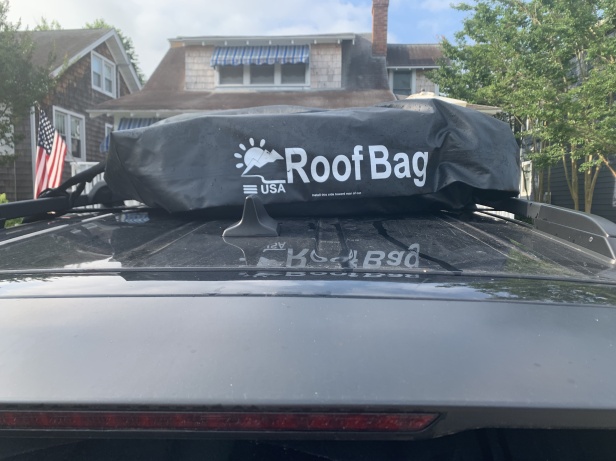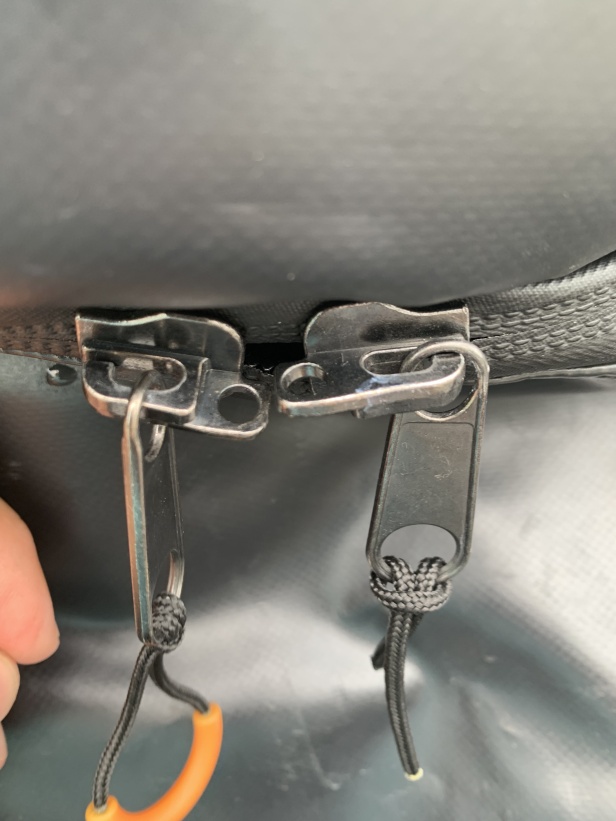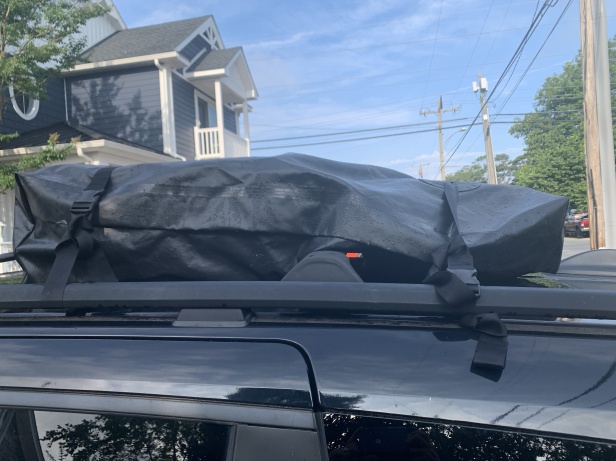Long long ago in the distant past, we were a family of three. Minivans were not even a glimmer in our eyes. The world was our oyster and we were ready to go traveling to the beach in our Toyota Prius hatchback with our baby girl. As new parents, of course we had to bring ALL the baby gear we could possibly stuff into that tiny car. We had baby toys, a pack and play, a stroller, and the kitchen sink. We just had no way to store it all in our tiny car and began searching for solutions. A couple things jumped out immediately. We had no roof rack. Traditional rooftop carriers would not work without some serious aftermarket modifications. We did not have a trailer hitch, so we could not mount a small gear tray in the back. We were stuck and needed something fast.
Enter the Roofbag Rooftop Cargo Carrier. This thing has stood the test of time and we even use it to this day strapped to the top of our minivan’s roof rack for our annual beach trips. Overall this is a winner, but there are a few things about it that might not work for everybody. Let’s dig in.

The Design
Ultimately this is a large, waterproof bag that sits on top of your car. It is incredibly spacious, measuring at 48″ long by 38″ wide by 11″ to 18″ tall (it is taller at the back than the front). The total capacity is listed at 15 cubic feet, which is consistent with the dimensions. For our family, that means we can fit at least 2 large suitcases (28″ long by 20″ wide by 12.5″ tall) and 1 smaller suitcase (21″ long by 14.5″ wide by 9″ tall) with room to spare. Try as I might, I just cannot fit another hardshell suitcase up there (and I played a good bit of Tetris in my day), but you could easily squeeze another soft bag to really take advantage of all that space. Ultimately the Roofbag rooftop cargo carrier can fit most of what a family of 5 needs for a week-long vacation, with the assumption that more gear is going inside of the vehicle.
One thing I like about the RoofBag is the heavy duty zipper that goes nearly all of the way around the bag. The rubber loops tied to the zipper are pretty weak and broke easily, but it’s nothing a little paracord cannot fix. The zipper also has a way to zip tie or lock them together for security. While this may offer peace of mind, it’s more for show than anything else. Although the bag material is thick rubber, it could easily be cut open with a pocket knife. But if your plan is to just make it harder for a thief, it’s a nice feature. There is also a nice flap that covers up the zipper, likely to keep driving rain out. I have never once had issues with rain getting into the RoofBag.

The RoofBag rooftop cargo carrier is held in place with a strap in the front and a strap in the back. Each strap passes through two loops on the RoofBag and under the roof rack to lock the everything in place. The straps can be tightened to make sure that your gear is not going anywhere, even at highway speeds. No roof rack? The straps can be fed through the car itself before shutting the doors (note: probably will not work with sliding doors). Now this all sounds good in theory, but it was a major annoyance of mine when we used it with our Prius. The strap was held taut across the inside of the car with the car doors, which meant that every time I moved my head, I brushed up against the strap. While not a dealbreaker in its own right, it is something to consider if you plan to use the RoofBag with a vehicle that does not have a roof rack.

Function
The RoofBag does a great job at storing gear and helping get it from point A to point B dry and secure. There are a few details to consider, however, when looking at it versus rigid shell roof top carriers. Each time you install the RoofBag, you need to make sure you do not have a lot of empty space in the front of the bag. You also need to make sure it is mounted correctly in between roof rack cross bars when using a roof rack. Why, you might ask? The deafening sound of the roof bag flapping in the wind and smacking against the top of your sweet whip. Even if anchored down really well, we’ve had some pretty noisy rides, to the point that we’ve pulled over, adjusted luggage, and started up again just to get rid of the annoying sound. If you are only using the RoofBag occasionally, it can be easy to forget some of these details, so this is my reminder. Come up with a system and stick to it or else you’re gonna have to blast that radio just to drown out the incessant flapping noise. Another minor annoyance related to noise is that when you get to your destination and empty out your RoofBag, you need to take it down or else the empty bag will flap against your roof as well. This means that for every trip you take, you are installing the RoofBag twice. Although the RoofBag setup is fairly quick, it does add time as you are desperately trying to check out on time.

Storage
Now this is where the RoofBag begins to shine again. Unlike rigid carriers, the RoofBag can be folded up and stored easily on a shelf or in a closet. It is somewhat like an air mattress or sleeping bag where you’ll never get it folded as nicely as when you first bought it, but it will take up significantly less space than the alternative. This is probably one of my favorite features of the RoofBag and why we were comfortable buying one when we were living in a condo without a significant amount of free space. Even with more storage space these days, I still appreciate the low footprint of the RoofBag.
Pros
- Very spacious and can fit several suitcases with room to spare
- Waterproof design with thick rubber body and protected zipper
- No roof rack necessary, but highly encouraged
- Low storage footprint means you don’t need tons of space
Cons
- Less aerodynamic than a rigid carrier = poor gas mileage
- Noisy if installed incorrectly or empty
Rating: 4/5

Overall I give the RoofBag Rooftop Cargo Carrier 4 stars out of 5. I really like the simplicity of the design and the ability to put it away with minimal storage space required. I’ve used the RoofBag at least a dozen times over the past several years and highly recommend it.
Let me know what you thought about the article. Thinking about purchasing a RoofBag or do you recommend any alternatives? As always, we are interested in your feedback!


Great review looking forward more.
LikeLike
I appreciate that! We’ll keep them coming 👍🏻
LikeLike